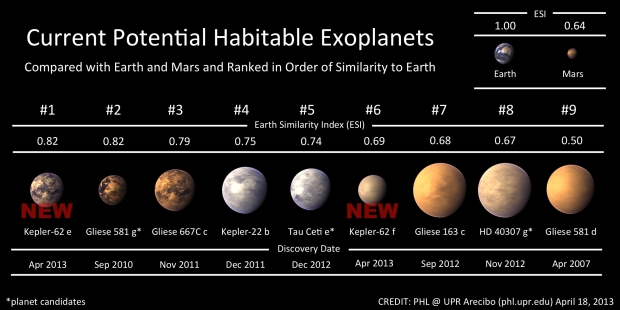Extrasolar planets which are also called as exoplanets are planets which are outside the solar system. As of July 2013, NASA has identified 919 such planets, out of which 262 may be habitable planets. This planet hunting undertaken by NASA has received major contribution from Kepler Mission.
The latest being a five-planet system that includes a “hot mars” and 4 super-Earths, two of which might even host liquid water. Even though these are not the Earth-like exoplanets the Kepler plans to discover, they are still quite close.
Named as Kepler-62 system it lies 1,200 light- years away around an orange, hydrogen- fusing K2 star about two-thirds the size of our Sun. The hot Mars whips around the star every 12 days; two hot super-Earths complete orbits every 6 days and 18 days. The final two worlds, Kepler-62e and Kepler-62f, are 60% and 40% bigger than Earth, respectively, and their orbits last 122 days and 267 days. This discovery comes just months after Kepler Mission had discovered the earth-like exoplanet named KOI-172.02 on 7th January, 2013. The image below shows a list of some of the exoplanets which may be earth-like.

In order to prove an exoplanet being Earth like, certain criterias need to be fulfilled. There are two approaches which the scientists look into. One way is to assume that the planets are rocky, with atmospheres thick with water vapor and carbon dioxide. Under these strict assumptions, Kepler-62f would receive enough stellar flux to keep liquid water on its surface, with the help of greenhouse effects. But in this case Kepler-62e would be too hot.
The second approach seems to be liberal as it defines the habitable zone by referring to the orbits and atmospheres Venus and Mars had billions of years ago, when they were still able to host liquid water. This method allows Kepler-62e to sneak in as well. But the question still remains whether these planets are actually habitable. The reason being their masses are too low to nail down via radial velocity or variations in the transit timings, so with just their sizes astronomers can only speculate about what they’re made of. Still, by not finding these other signals, the team can limit Kepler-62e to 36 Earth masses and Kepler-62f to 35 Earth masses. If the planets are both rocky and many times Earth’s mass, they might be very geologically active. Then again, since Kepler-62 is 7 billion years old, the planets could have simmered down by now.
On the other hand, an Earth-mass water world could have an ocean, but deep down it would turn into pressurized ice. After this discovery there is certainly excitement among the media. Yet despite the media fanfare, astronomers proceed with caution. Caleb Scharf from Columbia University suggests, “I’d be hesitant to call any of these worlds potentially ‘Earth-like’, but their discovery is definitely leading us closer and closer to places that might represent alien, but nonetheless similar, environments to our own.”
Exploration and discovery of such giant exoplanets are definitely an encouraging sign towards finding life in space.

































